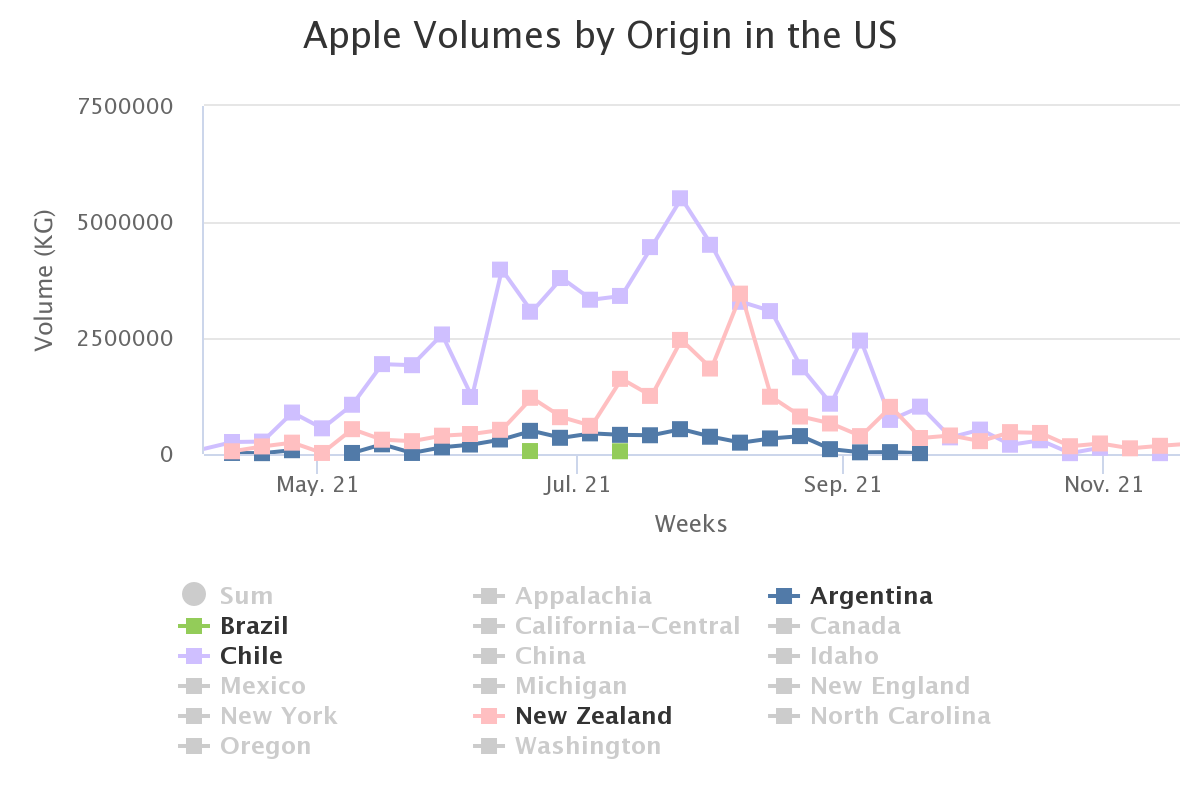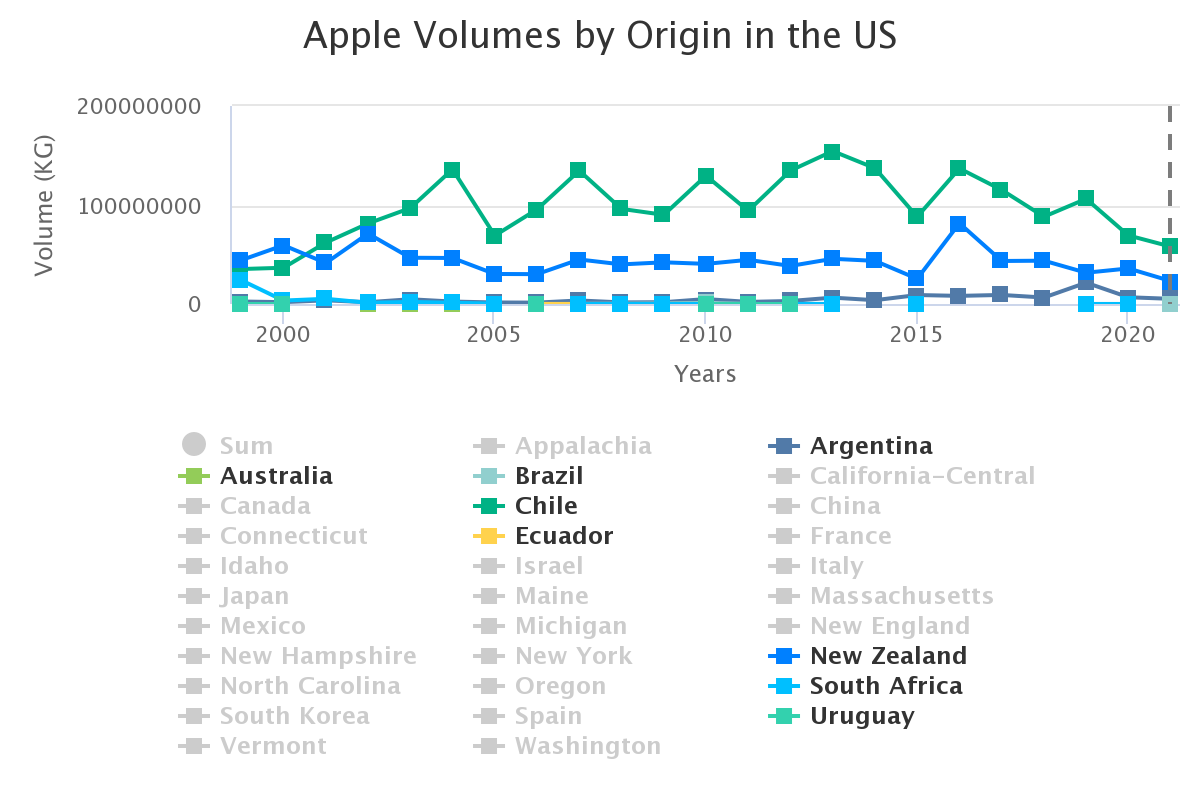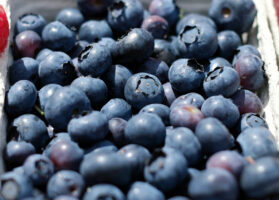2022 Southern Hemisphere apple crop forecast suggests a decrease of 7%
Overview of apples in the U.S. market, complemented by charts from Agronometrics. Original published on February 23, 2022.
On the occasion of its Annual General Meeting, the World Apple and Pear Association (WAPA) has released the Southern Hemisphere apple and pear crop forecast for the upcoming season. According to the forecast, which consolidates the data from Argentina, Australia, Brazil, Chile, New Zealand, and South Africa, apple and pear production is estimated to decrease by 7% and 6% respectively in 2022 compared to the previous year.

Source: USDA Market News via Agronometrics.
(Agronometrics users can view this chart with live updates here)
On 24 February 2022, on the occasion of its Annual General Meeting, the World Apple and Pear Association (WAPA) has released its 2022 apple and pear crop estimate for the Southern Hemisphere. This report has been compiled with the support of ASOEX (Chile), CAFI (Argentina), ABPM (Brazil), Hortgro (South Africa), APAL (Australia) and New Zealand Apples and Pears, and therefore provides consolidated data from the six leading Southern Hemisphere countries.
WAPA’s Secretary General Philippe Binard commented “This forecast is released for the global apples and pears sector on the background of many uncertainties, including the geopolitical tension, the increasing costs for production, the impact of the rise of logistic costs and limited container availability, labour shortage and the increasing concerns of declining consumption due to economic situation”
The 2022 Southern Hemisphere apple crop forecast suggests a decrease of 7% to a total of 4.864.000 T compared to last year (5.217.000 T), mainly due to the 30% decrease in Brazil and the 11% decrease in Argentina. Australia and Chile are also forecasted to decrease their production by 3% and 2% respectively. New Zealand and South Africa are the only countries where apple production is expected to increase (15% and 4% respectively). Chile is expected to remain the largest Southern Hemisphere apple producer in 2022 (1.455.000 T), followed by South Africa (1.163.000 T), Brazil (900.000 T), New Zealand (590.000 T), Argentina (445.000 T), and Australia (311.000 T). With 1.706.000 T, Gala remains by far the most popular variety, although its production is expected to decrease by 7% compared to 2021. Despite the decrease in production, exports are forecasted to remain stable overall at 1.744.762 T, with the larger volumes exported by New Zealand (+17%) and South Africa (+6%) compensating for the 65% decrease in Brazilian apple exports.
Regarding pears, the Southern Hemisphere growers predict a 6% decrease of the crop, which will drop to 1.229.000 T. This is mainly due to the 13% decrease in Argentina, the 11% decrease in Chile, and the 6% decrease in Australia. New Zealand and South Africa, on the other hand, are expected to increase their production by 31% and 5% respectively. Argentina remains the largest producer in the Southern Hemisphere (522.000 T), followed by South Africa (492.000 T), Chile (122.000 T), Australia (81.000 T), and New Zealand (11.000 T). Packham’s Triumph remains the most produced variety (444.000 T, despite a 4% decrease compared to 2021), followed by Williams’ bon chrétien pears (306.000 T). Export figures are expected to decrease by 6% compared to 2021 to a total of 641.207 T, mainly because of a 14% decrease in Argentinian exports.
In the Northern Hemisphere, the stocks in the USA stood at 1.478.180 T (-1% compared to last year) for apples and 149.553 T for pears (+32% compared to last year) on the 1st of February. In Europe, apple and pear stocks stood at 3.606.980 T (7% up from last year) and 408.340 T (30% down from last year).
Philippe Binard commented: “Seasonal developments clearly demonstrate the impact of logistics and costs on international trade also for Northern Hemisphere suppliers, with the USA concentrating sales for apples and pears in North America. European markets continue to be affected by the Belarus embargo, while the recent developments in Ukraine will also impact sales to all the destinations in Eastern Europe, including Russia, for all global apples and pears suppliers. It is important to continue building efforts to stimulate the consumption”.
WAPA’s Annual General Meeting also hosted a discussion on CO2 emissions and how apple and pear production can reach carbon neutrality or even have a positive contribution to the environment. WAPA will continue to cooperate on this topic with its members in a dedicated working group based on the input and expertise of the University of Bolzano (Italy).
Finally, the Annual General Meeting also confirmed that Prognosfruit will return as an in-person event in the first half of August 2022 in Belgrade (Serbia). The exact date of the event will soon be announced on the Prognosfruit website.

Source: USDA Market News via Agronometrics.
(Agronometrics users can view this chart with live updates here)
The News in Charts is a collection of stories from the industry complemented by charts from Agronometrics to help better tell their story.
Access the original article with this (Link)






